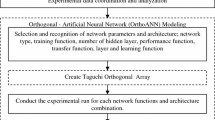Abstract
Investigating the effect of process parameters on material removal rate and surface roughness is very important for process planing in wire electro-discharge machining. In this study, wire electro-discharge machining of cementation alloy steel 1.7131 is experimentally studied, then linear regression model and feedforward backpropagation neural network were established to predict surface roughness and material removal rate for effective machining. The full factorial experiment was chosen for experiments. Experiments were performed under different cutting conditions of pulse current, frequency of pulse, wire speed, and servo speed. The optimized neural network with the best performance for prediction had eight neurons in the hidden layer, capability with 0.773 % overall mean prediction error, while 2.547 % errors was revealed by regression model. Totally, the comparison of the results showed that the neural network is more robust with better accuracy.
Similar content being viewed by others
References
Rajarshi M, Shankar C, Suman S (2012) Selection of wire electrical discharge machining process parameters using non-traditional optimization algorithms. Appl Soft Comput 12(8):2506–2516
Jain V (2005) Advanced machining processes. Allied Publishers Pvt. Limited, New Delhi
Sarkar S, Mitra S, Bhattacharyya B (2005) Parametric analysis and optimization of wire electrical discharge machining of γ-titanium aluminized alloy. J Mater Proc Tech 159:286–294
Shajan K, Shunmugam M (2005) Multi-objective optimization of wire-electro discharge machining process by non-dominated sorting genetic algorithm. J Mater Proc Tech 170:133–141
Ramakrishnan R, Karunamoorthy L (2006) Multi response optimization of wire EDM operations using robust design of experiments. Int J Adv Manuf Technol 29:105–112
Mahapatra S, Amar P (2007) Optimization of wire electrical discharge machining (WEDM) process parameters using Taguchi method. Int J Adv Manuf Technol 34:911–925
Probir S, Abhijit S, Surjya K (2008) Soft computing models based prediction of cutting speed and surface roughness in wire electro-discharge machining of tungsten carbide cobalt composite. Int J Adv Manuf Technol 39:74–84
Vamsi K (2010) Optimizing surface finish in WEDM using the Taguchi parameter design method. J Braz Soc Mech Sci Eng. doi:10.1590/S1678-58782010000200002
Pujari S, Koona R (2011) Effect of WEDM conditions on surface roughness: a parametric optimization using Taguchi method. Int J Adv Eng Sci Tech 6(1):041–048
Somashekhar K, Jose M, Ramachandran N (2012) A feasibility approach by simulated annealing on optimization of micro-wire electric discharge machining parameters. Int J Adv Manuf Technol. doi:10.1007/s00170-012-4096-1
Aniza A, Bulan A, Norliana M (2012) WEDM: influence of machine feed rate in machining titanium Ti-6Al-4V using brass wire and constant current (4A). Procedia Eng 41:1812–1817
Debabrata M, Surjya K, Partha S (2007) Modeling of electrical discharge machining process using back propagation neural network and multi-objective optimization using non-dominating sorting genetic algorithm-II. J Mater Proc Tech 186:154–162
Aykut C, Sukru O, Temel V (2012) Modeling the influence of a process control agent on the properties of metal matrix composite powders using artificial neural networks. Powder Tech 228:26–35
Author information
Authors and Affiliations
Corresponding author
Rights and permissions
About this article
Cite this article
Shakeri, S., Ghassemi, A., Hassani, M. et al. Investigation of material removal rate and surface roughness in wire electrical discharge machining process for cementation alloy steel using artificial neural network. Int J Adv Manuf Technol 82, 549–557 (2016). https://doi.org/10.1007/s00170-015-7349-y
Received:
Accepted:
Published:
Issue Date:
DOI: https://doi.org/10.1007/s00170-015-7349-y




